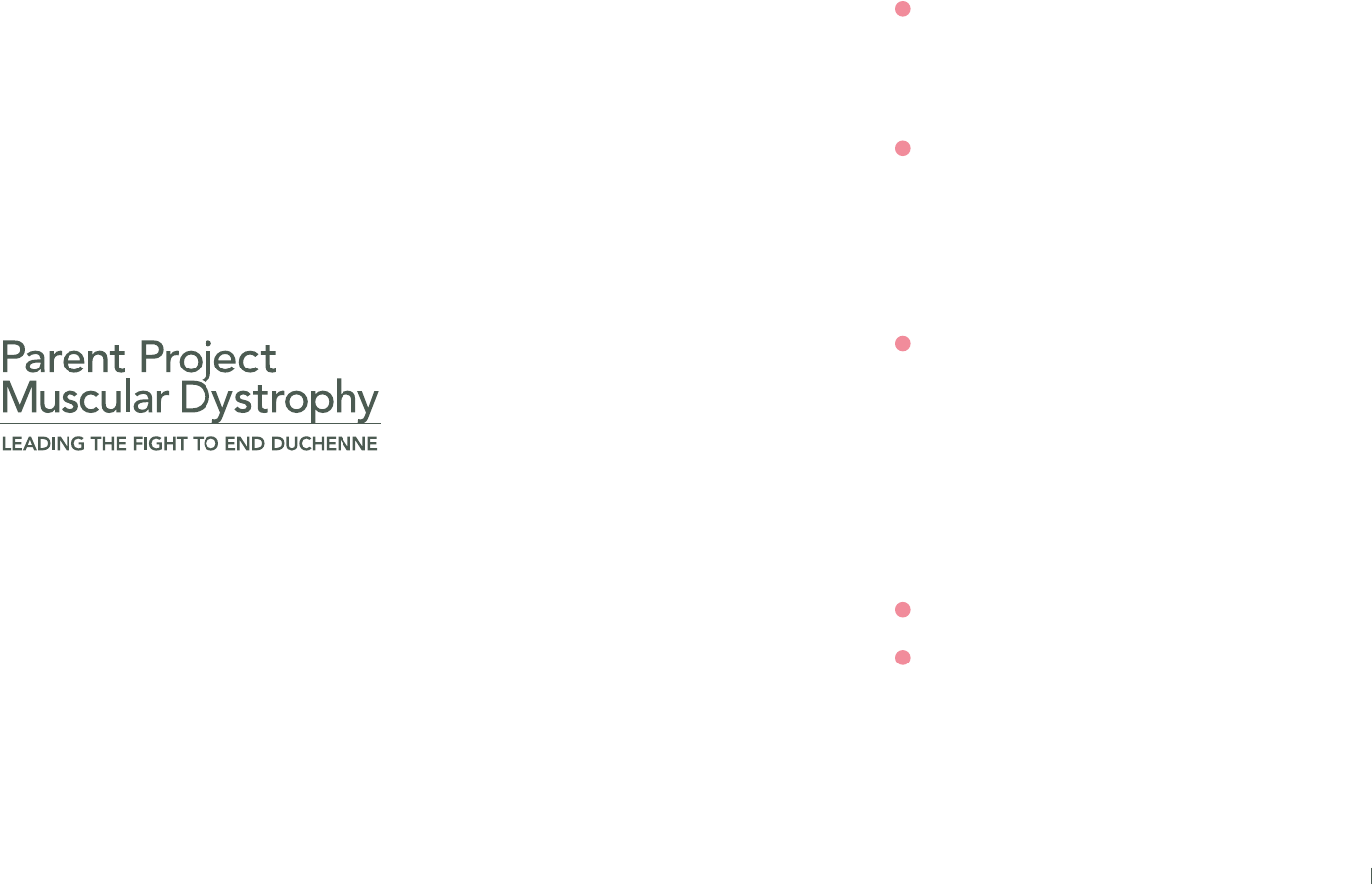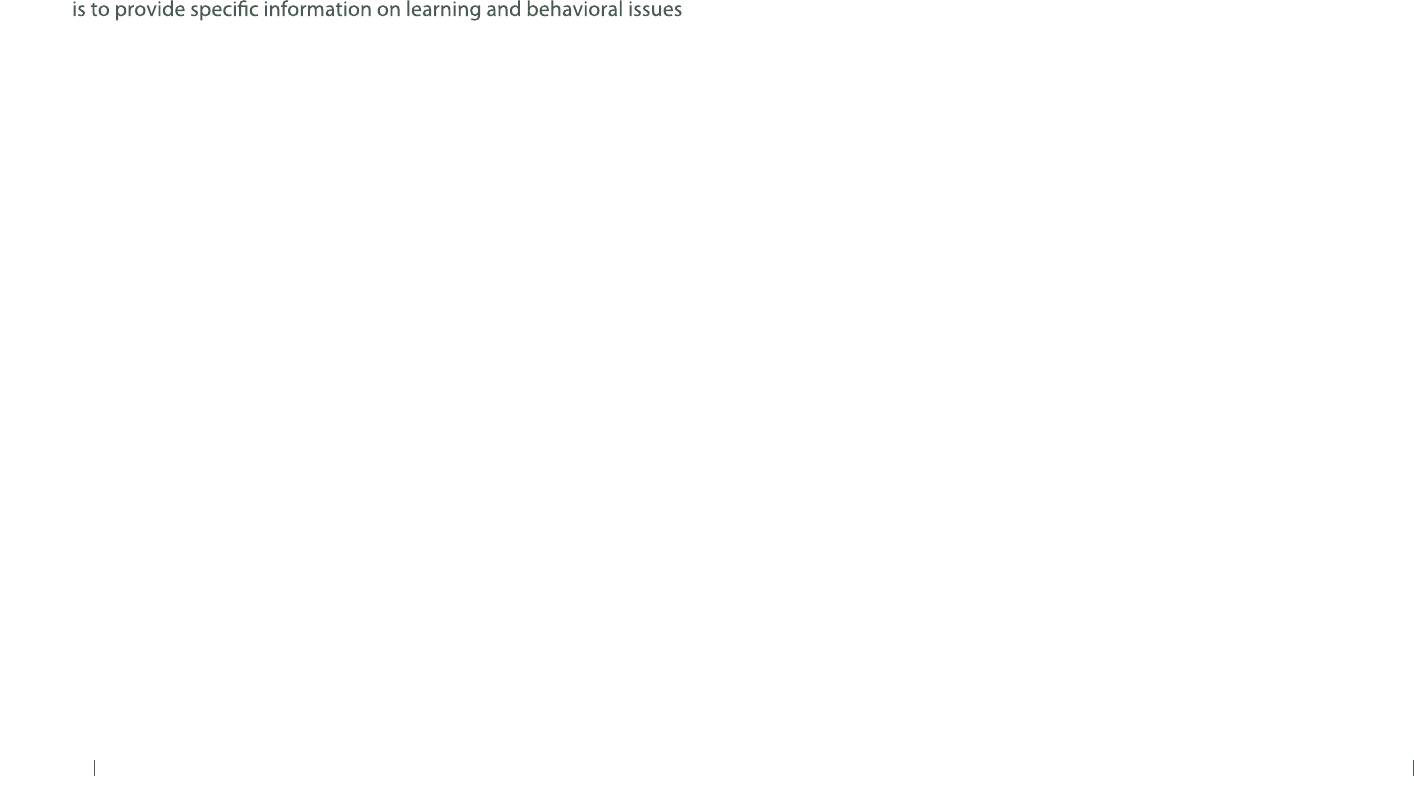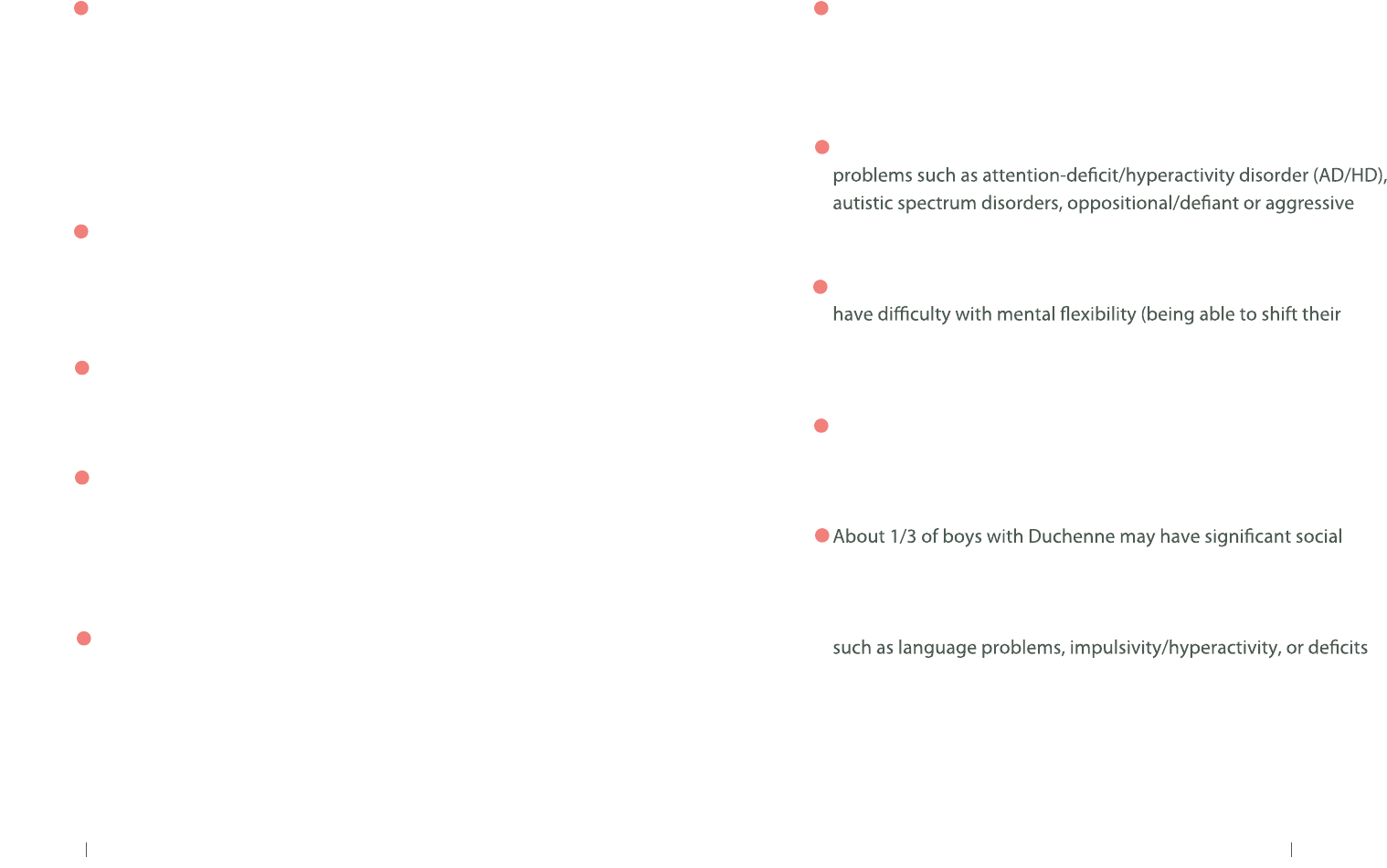
Learning and Behavior in
Duchenne Muscular Dystrophy
for parents and educators
OUR MISSION
To improve the treatment, quality of life, and long-term outlook for
all individuals a ected by Duchenne muscular dystrophy through
research, education, advocacy, and compassion.
Parent Project Muscular Dystrophy
T. 800.714.5437
ParentProjectMD.org

Learning and Behavior in
Duchenne Muscular Dystrophy
for parents and educators

i
contents
How to Use this Guide ii
Introduction to Learning and Behavior Concerns
1.1 Learning and Behavior Summary
4
1.2 Cognitive and Behavior Issues at Dierent Stages
8
1.3 Assessment
16
Learning Issues and Interventions in Duchenne
2.1 Overview of Intellectual Ability
22
2.2 Language
26
2.3 Attention, Listening, and Memory
2.4 Executive Functioning
2.5 Learning Disabilities
30
34
38
Behavioral and Emotional Adjustment in Duchenne
3.1 Coping with Duchenne
3.2 Depression and Anxiety
3.3 ADHD
3.4 Oppositional Explosive and Agression
3.5 Autistic Spectrum Disorder
3.6 Sensory Process Disorder
3.7 Obsessive Compulsive Disorder
3.8 Social Interactions
50
54
58
64
74
78
82
86
Recommended Resources
Appendix
1
2
3
4
5
Copyright © by Parent Project Muscular Dystrophy
Version 1, March 2011
ParentProjectMD.org
OUR MISSION
To improve the treatment, quality of life, and long-term outlook
for all individuals aected by Duchenne muscular dystrophy
through research, education, advocacy, and compassion.

ii
education matters
iii
a note to parents and professionals
HOW TO USE THIS GUIDE:
You are probably reading this because you are concerned about
your son’s behavior or learning, or because you want to be
proactive in making his academic career as positive as it can be.
In either case, you are looking for information, guidance and
assistance on how to best serve his needs so that he has the same
opportunities for success as his peers. The purpose of this module
that may arise in the classroom and at home.
You should not automatically assume that all of the information in
this module will be relevant to your child. Like any other group of
children, among children with Duchenne you’ll nd very dierent
temperaments, behavioral patterns, and learning styles. Our hope
is that this module will increase awareness of potential problem
areas, so that any diculties can be identied early and addressed
quickly.
Research, clinical, and educational experience
provide clues about behavior and learning issues that are more
common in boys with Duchenne. This module reviews those
issues, and potential interventions to improve your boy’s experience
in the classroom (and maybe at home).
The best way for your child to have his needs met is for parents and
professionals to come together in a collaborative manner. Please
use this module, together with the other Education Matters
materials, as a starting point for assessing the needs of every young
person with DMD and as a means of enhancing communication
between everyone involved.
After you read this guide and gather other information, consider
setting up a meeting between parents and teacher (and other
school personnel). This should ideally take place before the school
year starts. During the meeting, parents should take time to review
relevant behavioral or learning issues with the teacher. Point out
relevant learning and/or behavior issues and discuss how they are
relevant to your child. If your child has multiple needs in the
classroom, consider working with the teacher to prioritize what
should be addressed rst.
Written by: James T. Poysky, PhD
Clinical Assistant Professor, Baylor College of Medicine, USA
Contributing Authors (in alphabetical order):
Marni Axelrad, PhD
Assistant Professor, Baylor College of Medicine, USA
Morgan Bender, BA
Special Education Teacher, Rise School, USA
Liza Bonin, PhD
Assistant Professor, Baylor College of Medicine, USA
Jill Castle
Raising Special Kids, USA
Jos Hendriksen, PhD
Pediatric Neuropsychologist, Kempenhaeghe Epilepsy Center, Netherlands
Veronica J. Hinton, PhD
Assistant Professor of Neuropsychology, Columbia University, USA
Kelli Miller, M Ed
Educational Consultant, San Diego, CA

2
intro to learning & behavioral concerns
In this section:
Section 1:
Introduction to Learning
and Behavioral Concerns
More Common in Children
with Duchenne Muscular Dystrophy
1.1 Learning and Behavior Summary
1.2 Cognitive & Behavioral Issues at
Dierent Stages
1.3 Assessment
Dystrophin is usually present in the brain as well as in the muscles,
and scientists think that when dystrophin is missing (as in DMD),
brain neurons may not function as eciently as they should.
This is probably why there is an increased chance for
developmental, cognitive, learning, and behavioral diculties
among boys with DMD. Not every child with DMD is going to
have problems with learning or behavior.

1.1
Learning and Behavior Summary

5
education matters
6
Boys with Duchenne may have problems with motor planning,
which is separate from issues related to their muscle weakness.
Problems with motor planning may cause a child to appear
clumsy, uncoordinated, or as having poor hand-eye coordination.
There is also an increased chance for neurodevelopmental
behavior, and sensory processing disorder.
Some boys may appear to have obsessive-like features, and may
thought process to accomodate changes in expectations or
circumstances).
Boys with Duchenne also have an increased chance for emotional
problems such as anxiety or depression, similar to what is seen
in other chronic medical conditions.
problems (e.g., making and maintaing same-age friendships,
social maturity, etc.). This may be due in part to physical
limitations, but may also be because of cognitive weaknesses
in social judgement, social reciprocity, and perspective taking.
1.1 Learning and Behavior Summary
Similar to other kids, boys with DMD can have a broad range of IQ scores
(including well above average), and most boys are in the “normal” range
of intellectual and learning ability. However, boys with DMD are more
likely to have somewhat lower IQ and academic test scores than other
children their age. There is an increased, though low, risk of
mental retardation (which means an IQ below 70 and a reduced ability
to live independently).
Learning and Behavior Summary
Problems with short-term verbal memory (also called working memory)
are the most common nding, and can be present even in children with a
high IQ. This has an impact on the amount of information boys can take
in and hold in mind at any one time.
Language development can be problematic for children with Duchenne,
including language comprehension and expression. Basic vocabulary is
less likely to be aected.
Weaknesses in phonological (the distribution and pattern of speech
sounds) awareness/processing, combined with problems in short-term
verbal memory, can increase the chance for a learning disability. This is
probably why the rate of dyslexia (reading problems) may be as high as
40% in boys with Duchenne.
Writing and mathematics disorders are less well studied, but evidence
suggests that they can also be problematic.

1.2
Cognitive & Behavioral Issues
at Dierent Stages
The following section is broken into age and
grade categories.

10
Cognitive:
Parents and teachers may notice concerns about language
development during this age period. The problem may be
obvious, such as a lack of basic vocabulary, or may be subtle,
in that they have a normal vocabulary but problems
remembering or processing larger amounts of verbal
information or expressing themselves. Weaknesses in
phonological awareness and verbal memory place boys
with Duchenne at increased risk for developing learning
disabilities, especially dyslexia.
Problematic behaviors are quite common in all preschool
children, and boys with DMD are no dierent. However,
young boys with DMD may have more diculty with impulsivity
and emotional control than other children their age. They are
also more likely to be rigid and inexible in their thinking,
which can result in noncompliance or arguing. They may
have diculty making transitions. They may also be taking
steroid medication with side eects that can impact their
behavior, such as making them more emotional and active
than normal.
pre-k, kindergarten & early
elementary (ages 1–7)
Behavior:

12
Cognitive:
Diculty mastering academic material is a frequent concern
during the primary years. Academic diculties may be due to
specic learning disabilities such as dyslexia or other cognitive
decits. Problems with short-term memory and attention may
be problematic for boys with DMD at this stage, but may be
overlooked by parents and teachers because they are not
disruptive. As boys progress through the grades and more
and more independence is expected in their work, problems
with planning, organization, initiation and self-evaluation may
become more apparent (these types of skills are collectively
referred to as “executive skills”).
elementary & middle school
(ages 7–11)
Behavior:
Children with DMD tend to become more aware of their
dierences and limitations during this stage. Although most
boys adjust well to their condition over time, there may be
times of emotional distress because of DMD. Boys age 8 to
10 years may be most likely to have adjustment problems, as
this is usually the time just prior to transition to regular use of
a wheelchair.

14
junior high & high school
(ages 12-18)
Cognitive:
As young men with DMD grow older and expectations for
responsibility increase, problems with short-term memory
and executive functioning can interfere with their ability to
keep track of and eciently complete assignments and
projects. This is likely to become more problematic as the
complexity of their work increases, and for this reason
learning problems can happen for the rst time during this
age range.
Behavior:
As with any child, adolescence may be a dicult time for
young men with DMD. Physical limitations and disruption
in physical development that may occur with some medical
treatment (e.g., short stature or delay of puberty from steroid
treatment) may make adolescence more problematic. This
can also be a dicult time for teens who are unable to
establish their independence because they require more care
and assistance from others, such as parents. As muscle weakness
progresses, they are at risk for becoming more isolated or
socially withdrawn. Parents and teachers should look for
signs of chronic sadness, depression, or anxiety.

1.3
Assessment

17
education matters
18
1.3 Assessment
Recommended learning & behavior assessments
for children with Duchenne
Screening for autism spectrum disorder
Dyslexia screening
Comprehensive neuropsychological evaluation
1.3 Assessment
Given the increased risk of cognitive and emotional problems in
DMD, we suggest early assessment and intervention. Some
assessments should be done for all children with DMD (as described
on right). Other assessments can be done if concerns arise. Given the
complex nature of DMD, assessments should be done by people with
expertise that is appropriate to the methods of assessment. Sometimes
the expertise oered by your local school isn’t enough for your child’s
initial assessment. If possible, it is best to visit a child neuropsychologist,
but other child psychologists also oer appropriate assessment services.
Parents and Teachers – Please raise any concerns that you might
have about the child’s development, cognitive ability, academic
progress, emotional adjustment, or behavior as soon as possible.
Please do not wait to see if the child will grow out of it! In general,
the earlier you start interventions the more successful they will be.
Timing: between 2 and 3 years of age
Timing: If concerns arise
Timing: Kindergarten or 1st grade, or in response
to concerns or change in school functioning
Areas assessed may include, but are not limited
to, IQ, language, visual processing, ne motor
skills, memory, attention/impulse control,
executive functioning (e.g., planning, problem-
solving, initiation, mental exibility), academic
skills, academic processes (e.g., phonological
awareness), and behavior/emotional adjustment.
•
•
•
•

20
learning issues in Duchenne
In this section:
Section 2:
Learning Issues
in Duchenne
While scientists are still guring out the exact role of dystrophin
in the brain, not having dystrophin seems to cause an increased
risk for specic cognitive weaknesses and learning diculties.
This does not mean that all boys with Duchenne will have decits
in these areas.
Parents are STRONGLY encouraged to seek assistance
from appropriate professionals if concerns arise
regarding any of these problem areas.
2.1 Overview of intellectual ability
2.2 Language
2.3 Attention, listening, and memory
2.4 Executive functioning
2.5 Learning disabilities

2.1
Overview of Intellectual Ability

23
education matters
24
2.1 Overview of Intellectual Ability
Boys with DMD are at increased risk for developmental
delays. The most common delays are in gross motor
skills such as sitting, walking and running. However,
boys with DMD are also at increased risk for delays in
other areas such speech/language development, motor
planning, and ne motor dexterity. Some boys are
later than usual in potty-training and self-help skills.
Similar to the general population, IQ scores in DMD
can range from well above average to below average.
Most boys with DMD have an IQ that is in the normal
range. However, they are also at increased risk for
having an IQ that is below average or in the mental
retardation range (IQ score less than 70). Boys with
DMD may also have a specic pattern of cognitive
strengths and weaknesses (as described below) that
may not be accurately represented in an overall IQ
score. Thus, educators and parents should take care
when interpreting IQ scores for DMD boys.
Interventions for Developmental Delays:
Interventions for developmental delays (e.g., speech/
language, physical, and occupational therapies) typically
involve various therapies and should be targeted on
improving specic skills. Children with intellectual
impairment will need signicantly more repetition,
rehearsal, and practice to learn new academic
information. Specic interventions are described in
the sections that follow.
boys with Duchenne
face an increased risk
for developmental
delays
2.1 overview of intellectual ability

2.2
Language

27
education matters
28
2.2 Language
Boys with Duchenne usually have a vocabulary that is in the
normal range, but may have more trouble with other language
skills. An area of weakness may be understanding complex verbal
information. Because of this, boys with Duchenne may have
diculty understanding expectations or following directions,
and may only get “part of the message”. Boys with Duchenne
may also have diculty with expressive language. This can
interfere with their ability to describe their ideas and ask questions.
Teachers should note that, because their basic vocabulary is usually
in the normal range, boys with Duchenne may give the impression
that their level of understanding is higher than it actually is.
Phonological processing skills are an area of language that can
be particularly problematic for boys with DMD. Good
phonological processing is a prerequisite for the development
of reading skills, and problems in this area place a child at risk
for the development of dyslexia. [See the Learning Disabilities:
Dyslexia section for more information about phonological
processing.]
Interventions for language:
Speech and language therapy is usually recommended for a
child with decient language skills. The therapy should focus
on improving skills that were shown to be weaker by the
child’s testing. Consider simplifying communication when
interacting with a boy who has language delays. Children
with weaknesses in this area may have diculty with
open-ended questions (“Why did you do that?”), and tend
to do better with yes/no questions or limited response options.
Ways to Simplify Communication:
• use concrete and clear terms and phrases
• adjust the vocabulary you use
• give smaller chunks of information
• introduce only one new direction/concept at a time
• have them explain things in their own words
2.2 language

2.3
Attention, Listening, and Memory

31
education matters
32
2.3 Attention, listening, and memory
If given repeated exposure, boys with DMD are generally able to
memorize the same amount of new information as other children.
However, the amount of information that they are able to take in
at any one time may be less than other children. This type of
memory is called short-term memory, or working memory. Boys
who have problems in this area may appear forgetful, have diculty
following directions, or seem to not listen. These memory
weaknesses are particularly related to verbal information, but some
boys also have diculty with visual information. Even boys with
DMD who have a high IQ and strong verbal skills can have this
pattern of memory weaknesses.
Boys with DMD have an increased chance for problems with attention,
concentration, and distractibility. They may also be “inecient” in the
amount of time it takes them to work through things (slow processing
speed), and may have diculty dividing their attention (multi-tasking).
For related information, see the section on ADHD.
Examples of interventions for attention,
listening, and memory problems:
•
Provide seating near the instruction area.
•
If the child can’t sit still, allow him to stand when working.
•
Instructions should be broken down into individual steps,
which are provided one at a time.
•
Break down new information into smaller chunks, and
check for understanding before moving on.
•
Consider eliminating time constraints for tests and give
extra time for assignments.
•
Provide a quiet, non-stimulating environment for test
taking or completing assignments, outside of the classroom
if necessary.
•
Develop a reward system to aid in work perseverance.
This should focus on rewarding positive on-task behaviors,
rather than punishing o-task behaviors.
•
Provide advanced warning of transitions (e.g. “Two minutes
until…”).
Provide clear expectations and remain calm, rm, positive,
and encouraging.
•
Keep the classroom well organized, structured, and controlled.
•
Summarize information at the end of each instructional lesson
to assist with synthesis, organization, and retention of the
information.
2.3 attention, listening, and memory
•

2.4
Executive Functioning

36
2.4 Executive Functioning
Research studies have been inconsistent, but there is
evidence that some boys with DMD have problems with
executive functioning. This is a term used to describe
skills that are needed to complete goal-oriented behaviors,
including things like planning, organization, initiation,
mental exibility, and self-analysis. Mental exibility in
particular appears to be more problematic in DMD than in
the general population. Boys with problems in this area
will have diculty adapting to changes in expectations or
requirements, or in transitioning from one activity to the
next. They can get stuck on one idea, and have a hard time
shifting their thinking away from it, even when others are
getting annoyed or angry with them. They may appear
stubborn or hard-headed, but it is important to keep in
mind that this reects a cognitive weakness rather than a
character aw. Problems with executive functioning
commonly occur in the presence of ADHD and autism.
some boys have issues
with goal-oriented
behaviors and
2.4 executive functioning

2.5
Learning Disabilities

39
education matters
40
2.5 Learning Disabilities
Although research has predominantly looked at reading, there is
evidence that suggests that children with DMD are at increased
risk for all three types of specic learning disabilities:
Dyslexia
Dyslexia is not a visual problem. It is a problem with sound-
segmentation and sound-blending while reading. Thus, the most
telling sign of dyslexia is when a child has diculty sounding-out
words. Dyslexia is a specic learning disability that results in diculty
learning to read. Although there are a number of dierent
factors that can play a role, research indicates that dyslexia is
mostly caused by decits in the following foundational skills:
Phonological processing:
Understanding that spoken words are
made of up small sounds (phonemes)
that are blended together, and that
these sounds can be identied and
manipulated.
Verbal memory span/working memory:
Verbal memory span, also called verbal
short-term memory, represents the
amount of new information you can
hold in mind at one time. Working
memory refers to the ability to keep
information in mind and manipulate it.
Rapid naming:
2.5 Learning Disabilities
i
Research has demonstrated that specic decits in verbal
memory span/working memory and phonological processing
are prevalent in DMD, and can occur across all IQ levels.
• Dyslexia (reading disorder)
• Dyscalculia (mathematics disorder)
• Dysgraphia (written communication disorder)
This refers to how quickly and eciently
someone is able to nd and retrieve
information from memory. With
sucient practice, the retrieval of some
information should become “automatic”.

41
education matters
42
Comments on Dyslexia Interventions
• Just telling a child with dyslexia to “read more” is not effective;
research has shown that independent reading by itself does
not correct the disorder. Research also indicates that the
most eective way to correct dyslexia is repetitive, intensive
phonics instruction.
• Some people think that sight-word memorization is a good
strategy for children with reading problems (teaching them to
recognize the word based on how it looks, not on sounding it
out). The problem is that they tend to max out at around
3000-5000 words, which is far short of the number needed for
uent reading. Phonological awareness and phonics instruction
must be an integral part of the process.
• Children with dyslexia will forget the reading skills they have
learned if they are not reinforced or repeated. Thus, good reading
programs build upon and reinforce previously learned skills, rather
than switching to a different task or skill. Ongoing practice and
review of previously learned steps will be necessary.
be patient with the
child when attempting
to teach reading
skills
specific challenges & ways you can help (ages 7–11)
Compensatory strategies for dyslexia
Despite intervention, some children may continue to have
diculty reading. Compensatory strategies do not “treat”
the underlying problem like interventions do, but they may
make it easier for a child who is experiencing dyslexia to
succeed in the classroom. Below are modications that teachers
may need to make.
• Oral presentation of new information that the student
would otherwise have to read
• Allowing the use of books on tape when available, or
allowing someone to read the material to the child
• Oral presentation and responding during tests and
assignments, either in person or via use of a tape recorder
or voice recognition software
• Allowing extra time for the completion of assignments
• Removing time limits on tests
Preschool
• Difficulty with rhyming
• Problems identifying the
starting/ending sounds
of spoken words
• Difficult or inconsistent
identication of letter
names
Elementary + Beyond
• Problems learning/remembering
letter sounds
• Difficulty segmenting (“sounding-
out”) written words
•Difficulty blending sounds
together to make words
•Looking at the rst or last sound
in a word and guessing at the rest
• Dropping word endings while
reading (“slow” instead of “slowly”)
• Difficulty with spelling
• Slow, laborious, or “dysuent” reading
• Poor reading comprehension
Signs of Dyslexia:
• Be patient with the child when attempting to teach reading skills.
For children who struggle with dyslexia, it will be a long process that
requires lots of repetition and encouragement to build condence
and skills.

i
43
education matters
44
Dyscalculia (Mathematics Disorder)
There are two general areas of weakness that can contribute to
problems with mathematics. One is a weakness in mathematical
reasoning ability, which results in diculty understanding math
concepts. Children with problems in this area may have diculty
estimating amounts, understanding relative value (greater than,
less than), or understanding abstract or symbolic concepts in
math ("ten's place, hundred's place", money, fractions, etc.).
Another general area of weakness that can contribute to problems
with mathematics is memory for arithmetic operations. Children
with problems in this area have diculty remembering number
facts (e.g., multiplication tables), sequences/steps used in math
problems, or computing easy calculations in their head. Some
children may demonstrate problems in just one of these general
areas, while others may have diculty in both areas.
Interventions for Dyscalculia
Math Concepts
Children who are having diculty understanding math
concepts will benet from an increase in the use of
tangible objects and “real-life” examples when learning.
Numerical Operations
For a child to become procient at numerical operations
requires several things, including rote memorization of
math facts (e.g., counting/sequencing for young children,
multiplication tables for older children) and memorization
of math procedures (e.g., strategies or steps to complete
a problem).
dyscalculia & interventions
Compensatory Strategies
Compensatory strategies do not “treat” the underlying problem like
interventions do, but they may make it easier for a child who is
experiencing dyscalculia to succeed in the classroom. Examples include:
• Provide plenty of workspace for each problem on tests and
assignment sheets.
• Place steps for completing the problem at the top of the page
or on an index card, and list steps vertically, from top to bottom.
• Allow use of a number line.
• Allow use of a math facts table or calculator.
• Allow extra time for tests and assignments.
• Consider reducing the number of problems; focus on quality vs.
quantity if an assignment will be graded.

i
45
education matters
46
Dysgraphia (Disorder of Written Expression)
Writing is perhaps the most dicult academic task to master, as it
requires the successful integration of a number of skills. Problems
with muscle strength, ne motor dexterity, or motor planning can
make the physical aspect of writing dicult and frustrating for
some children. Children who have problems with language skills
can have diculties with spelling, grammar and syntax. Weaknesses
in executive functioning can result in diculty starting, planning
and organizing longer written projects.
Interventions for Dysgraphia:
Fine motor dexterity or motor planning:
• Occupational therapy to improve pencil control skills
• Structured repetitive handwriting programs that teach
strategies to form letters (for example, “Handwriting
Without Tears”)
Spelling Problems:
• These are usually related to weakness in phonological
processing. Target interventions to the aspects of
spelling that children are problematic for the child
having problems.
For example:
- Instruction in clapping/counting syllables
- Instruction in basic spelling rules (each word must
have a vowel, “I before E, but not after C”, etc.)
- Instruction in word segmentation and blending
• Memorization of common words that are exceptions
to spelling rules
dyscalculia & interventions
Compensatory Strategies
Compensatory strategies do not “treat” the underlying problem like
interventions do, but they may make it easier for a child who is
experiencing dysgraphia to succeed in the classroom. Examples include:
• Reduce paper and pencil tasks and decrease repetitive writing
assignments, but do not change essential elements.
• For older students, accompany writing assignments with very
specic steps and instructions, sequential outlines, etc.
• Provide copies of slides, teacher notes, and lecture outlines so the
student is not missing important information while trying to take notes.
When the student is given notes/outlines, require some activity of the
student in order to maintain his active participation in the learning process,
such as highlighting key words with a highlighter.
• Provide an opportunity for oral responses on tests or assignments
and/or allow dictation.
• Do not provide a handwriting or neatness grade. Allow the use of
cursive or printing, whichever is more legible.
• Allow for use of AlphaSmart or other keyboarding system.
• Do not grade for spelling, grammatical, or punctuation errors during
one-sitting assignments.
• Modify test formats to increase structure. For example, instead of a
general essay question, provide testing in multiple-choice, true-false, or
ll-in-the-blank formats.
Language Weaknesses:
• Limited vocabulary and diculty with expression (such
as grammar or sentence formation) may contribute to
writing problems.

48
cognitive and learning issues in Duchenne
In this section:
Section 3:
Behavior & emotional
adjustment in
Duchenne
While scientists are still guring out the exact role of dystrophin
in the brain, not having dystrophin seems to cause an increased
risk for specic cognitive weaknesses and learning diculties.
This does not mean that all boys with Duchenne will have decits
in these areas.
Parents are STRONGLY encouraged to seek assistance
from appropriate professionals if concerns arise
regarding any of these problem areas.
3.1 Coping with Duchenne
3.2 Depression and anxiety
3.3 ADHD
3.4 Oppositional, explosive, and aggressive behavior
3.5 Autistic Spectrum Disorders
3.6 Sensory Processing Disorder
3.7 Obsessive-compulsive behaviors
3.8 Social Interactions

3.1
Coping with Duchenne

51
education matters
52
3.1 Coping with Duchenne
Most boys with Duchenne cope well with their medical condition
and are described as emotionally well-adjusted. However,
keep in mind that even well-adjusted boys may experience
frustration, sadness, anger, or anxiety related to their Duchenne.
These are normal reactions to a stressful situation, and are
more likely to be triggered during important developmental
periods or times of change.
• Be available to talk with the child or with others about Duchenne.
• Help identify and address any specic cognitive or learning
diculty that is causing the child diculty.
• Adjust the classroom setup and activities to maximize inclusion
and participation of the child with Duchenne.
• Allow the child to be as independent as possible.
• Involve the child in decision making as much as possible in
an age appropriate manner (including his education and
healthcare/medical treatments).
• Help the child understand and express his emotions in a
healthy manner.
• Active listening is important in helping a child, adolescent, or
young man feel accepted and understood, and helps them
“process their emotions”. Several basic strategies help someone
you know you are actively listening, including comments about
how they appear to be feeling, summarizing what they are saying,
and asking questions.
• Don’t ask “Why...” questions, and don’t give them advice or tell
them that they shouldn’t be upset, etc. Just listening to them
and helping them clarify the situation and how they are feeling
will enable them to work through their distress. Keep in mind
that they typically just want to be heard and understood.
3.1 Coping with Duchenne
Ways to help maximize coping

3.2
Depression and anxiety

55
education matters
56
3.2 Depression and anxiety
While most boys with Duchenne are not depressed or anxious, there
is an increased chance when compared to other boys their age.
Depression is dierent from normal feelings of sadness in that it is
more pervasive, longer lasting (weeks to months instead of a day here
or there), and powerful (signicantly interferes with daily activities,
relationships, and goals). Here are some signs that boys and young
men with Duchenne may be experiencing depression and/or anxiety:
Signs of Depression
• Loss of enjoyment or interest in things they would
typically enjoy
• Physical symptoms (e.g. headaches, stomach aches)
• Irritability, moodiness, or aggression
• Less patience or lower frustration tolerance
• Overly sensitive or tearful
• Feelings of sadness and/or hopelessness
• Suicidal thoughts
• Poor concentration, memory, or decision making
• Changes in work habits or schoolwork
• Changes in appetite or energy level
Signs of Anxiety
• Signicantly worried or fearful
• Tense or uptight
• Jittery or trembling
• Problems separating from parents or other family members
• Experiencing chest pains, problem catching their breath,
stomach aches, headache, or dizziness (though these may
also be signs of a serious medical problem, so you should
always notify a healthcare provider about any of these
symptoms)
depression & anxiety
Interventions for depression and anxiety:
Depression and anxiety can be very serious conditions and should be
treated by mental health professionals. Mild to moderate symptoms
of depression and anxiety may respond well to psychotherapy, though
more severe cases may also require psychiatric consultation and
possibly medication.
Younger children are more likely to show symptoms of irritability,
aggression, over-sensitivity, or physical complaints, and do not
always seem outwardly depressed. Most children have diculty
describing their emotions or identifying the cause of their distress.
Therefore, they may not always be able to answer questions about
how they are feeling or why.

3.3
ADHD

59
education matters
60
3.3 ADHD
Boys with Duchenne are at increased risk for having an attention-
decit disorder. The formal name for this type of condition is
Attention-Decit/Hyperactivity Disorder (ADHD). The following
symptoms may indicate the presence of ADHD:
Types of ADHD
Predominantly Hyperactive-Impulsive Type
Predominantly Inattentive Type
Combined Type
Impulsivity
• Acts or says things without thinking
• Impatient or has difficulty waiting turn
• Interrupts/intrudes on others
• Talks excessively
• Acts too silly at inappropriate times
Hyperactivity
• Fidgets, can’t sit still
• Often leaves seat
• Difficulty playing quietly, overly wound up
Inattention
• Does not seem to listen
• Avoids doing things that require sustained mental effort
• Loses or misplaces important things
• Forgetful, absent-minded
• Rushes through things, makes careless errors
• Doesn’t complete work or turns things in incomplete
• Easily distracted, daydreams
3.3 ADHD
i
It is important to note that because of muscle weakness and physical
limitations, symptoms of hyperactivity may be less obvious in boys
with Duchenne. Thus, impulsivity may be the most obvious feature of
ADHD for these boys. They may also have reduced sensory tolerances
(see Sensory Processing Problems).
All types of ADHD may include weaknesses in executive functioning.
Thus, children with ADHD are more likely to have problems getting
started on things, and have diculty with planning, problem-solving,
and time management.
It is important to know that some of the cognitive patterns observed
in Duchenne can lead to a child being misidentied as having ADHD.
More specically, language or discrete short-term memory decits may
cause a child to appear inattentive or forgetful, or to have diculty
following directions. Mental healthcare providers should consider
these alternative possibilities prior to giving a boy with Duchenne a
diagnosis of ADHD.

61
education matters
62
Interventions for ADHD
Treatment and intervention often has three components:
The use of medication is the most eective component for
many boys. Approximately 80 to 90% of children with ADHD
obtain some benet from medication, although this is not
always complete improvement. Stimulants are the most
commonly prescribed medications. Most boys with DMD
respond well to treatment with stimulant medication.
However, stimulant medications should be used with extreme
care in any child with heart problems, which are common in
older boys with DMD. Thus, the doctor should closely monitor
the cardiac status of boys with DMD who are prescribed
stimulant medications. Some boys may have a minor increase
in heart rate and blood pressure when taking these medications,
even if they have not yet developed heart problems. It is unknown
what potential impact this could have on their heart over the long
run. There are non-stimulant medications that are also approved
for treatment of ADHD that may be a good option for some boys,
but they may also increase heart rate in some children.
Another component of ADHD intervention consists of psychosocial
strategies. Behavior modication therapy may be helpful in mild
to moderate cases of ADHD, and is most eective when focused
on parent training/consultation. This can also help improve
compliance and reducing arguing and temper tantrums.
Behavioral therapies are usually the most eective before
the child is 10 or 11 years old, so early intervention is key.
1
2
3
interventions for adhd
The third component of ADHD intervention usually involves
modifying or adapting the child’s environment to reduce the
impact that ADHD has on their daily activities. This includes
things like increasing structure and oversight during
activities, implementing compensatory strategies at school
or home, developing supports for memory and organizational
weaknesses, and implementing routines that can be followed
consistently.

3.4
Oppositional, Explosive, and
Aggressive Behavior

65
education matters
66
3.4 Oppositional, Explosive, and Aggressive Behavior
Boys with DMD are at increased risk for having signicant problems
with arguing, not following directions, temper tantrums, or refusing
to do what they are asked. Their oppositional and argumentative
behaviour may be the result of problems with mental exibility or
inability to be adaptive in their thinking. Adopting an overly punitive
discipline style (mostly focused on punishment) with children who
have these types of cognitive weaknesses usually results in
escalation of conict, power struggles, and an increase in negative
behaviors. Fatigue can contribute to behavior problems in DMD.
Steroid medication can also contribute to temper tantrums and
explosive behavior.
While analysis of parenting strategies is helpful, it is important to
understand that behavior problems are not always the result of
parenting style, and many children with behavior problems do not
respond to “typical” parenting strategies. Behavioral therapies may
assist parents in identifying certain situations that are likely to trigger
negative behaviours, and assist in developing alternative strategies
to try to correct them.
We recommend consultation with a mental health or behavioral
therapist. Therapy with a professional for these types of behaviors
should always include a large parent-training component, because
this approach tends to be much more successful than individual
“talk therapy” or “play therapy” with the child.
• Prioritize. You can’t change everything, so focus on 1 or 2 of
the biggest concerns and go from there.
• Develop and follow a routine as much as possible. Review
what is going to happen during the day. Give advance notice
of transitions, or changes in routine or expectations.
• Try to keep calm when a child is misbehaving. Angry parents
and teachers tend to escalate the situation.
• Focus on the positive. Strategies that only focus on punishment
do not promote positive behaviors, increase motivation, or change
attitudes. Rewarding/praising/encouraging good behavior is
more eective in the long run. Look for opportunities to say “yes”
instead of “no.” (“Yes, you can have a cookie, after you…”).
3.3 oppositional, explosive, and agressive behavior
Interventions for Oppositional, Explosive,
and Aggressive behavior
General Recommendations:

i
67
education matters
68
Strategies for Dealing with Oppositional, Explosive, and
Aggressive Behavior in Preschool and Early
Elementary Children
At Home
• Ignore negative behaviors when the behavior is not
aggressive or destructive.
• Praise positive behavior and create opportunities for
positive interactions and success.
• Reward positive behavior.
• Break directions up into small manageable steps.
• Be specic and concrete when explaining expectations.
• Use time out for aggressive behaviors (that is, remove the
child from any exciting activity and put in a time-out chair
alone, until calm).
At School
Classroom management for preschool-aged children
involves many of the techniques previously listed for
home behavior management. Some teachers nd
reward charts helpful for children aged three and up.
3.4 oppositional, explosive, and aggressive behavior
This type of strategy has elements that are similar to the preschool
strategies listed above. Essentially, the goal is to decrease negative
behaviors and increase positive behaviors through the use of rewards.
This type of plan makes the assumption that a child’s negative
behaviors result in some kind of gain (such as getting what he wants
or avoiding responsibility), or are due to low motivation or a desire to
gain control.
Step 1: Identify behaviors that should be reduced (e.g., angry
outbursts), and/or behaviors that should be increased (e.g., time
spent on homework). Prioritize and pick only one or two to start
with.
Step 2: Examine when and where these behaviors do (or don’t)
occur to see if there are obvious triggers, circumstances, or
surroundings that need to be changed.
i
Strategies for Older Children and Teens
At Home and School
Strategies to manage difficult behavior in older children
typically fall into one of two categories. Depending on
the characteristics of the child, one strategy or the other,
or a combination of both, may be benecial.
Behavior Modication Plan

69
education matters
70
3.4 oppositional, explosive,and aggressive behavior
Step 3: Set goals for change.
• Expectations for behavior should be very clear and highly
specic (that is, don’t say, “You need to be a good student
right now.”)
• Develop a reward system to implement when the child meets
the expectations.
- The reward should immediately follow the behavior. Long-
range rewards (such as earning a prize at the end of the
school year) are too abstract and distant from daily behavior
and are not effective. Also, if a child does not meet
expectations at the beginning of the program and loses the
chance to earn the reward, there is little reason for him to
keep trying.
- Always give praise, but other rewards will likely be necessary.
Younger children may need things like candy (not too much!),
stickers, pennies, or whatever else will motivate them. Older
children are more likely to respond to points or stars that
can be traded in for bigger prizes.
- Avoid strategies that focus only on punishment. This type of plan
does not promote positive behavior, does not change attitudes,
and emphasizes failure instead of success. One example of this is
to start a child with a certain number of points or on a certain
“behavior level”. Points are then removed or his level is downgraded
when he engages in negative behavior. This type of strategy will
not be effective for most children who have behavior problems.
- Do not give rewards before the expected behavior occurs
(such as, “I’ll give you your reward now, as long as you promise
to not have a temper outburst later”).
Behavior Modication Plan
• Involve the child in developing the goals, expectations and rewards.
• Be realistic in the amount of change you anticipate. Set small goals
initially so that everyone can experience some success. For example,
if a child is having a temper outburst 10 times a day, it is unrealistic
to expect that he can suddenly stop. A more realistic approach might
be to identify one time period during the day (such after lunch, or
when he gets home from school) that the behavior should not
happen.
• Consistency by the parent or teacher is very important.
Step 4: Evaluate progress in meeting goals and adjust plan as needed.

71
education matters
72
3.4 oppositional, explosive, and aggressive behavior
The goal of this strategy is to promote problem-solving skills. It
is particularly helpful for children who are chronically rigid and
inexible in their expectations, and/or when limit-setting or
punishment routinely escalate temper meltdowns. It assumes
that children want to do well and get along with others if they can.
They start arguing or having a temper tantrum because they have
weaknesses in skills (such as controlling their frustration, taking
another's perspective, generating alternatives, being exible in their
thought process, expressive language, etc.) that make it dicult for
them to resolve dicult or unexpected situations. This approach
attempts to improve their decient skills, thereby resulting in more
eective problem-solving and less negative behavior. The process
is highly exible and tailored to each child and the family/teacher,
but here is a general overview.
Step 1: Empathy and Reassurance
Identify and understand the child’s concerns and point of
view (such as completion of homework, attending an event,
or engaging in an activity).
• Validate how the child is feeling, and tell him his concerns
are important. Ask questions to help clarify why the child
is upset, but avoid "Why" questions ("Why are you so mad
about this?"). Show you are listening by paraphrasing what
he is saying. Don’t argue or point out how he is wrong. The
goal in Step 1 is to help him learn to express himself and to
"feel heard", and can be a helpful "de-escalation" tool.
Collaborative Problem-Solving Strategy
Step 2: Dene the Problem
Identify and explain the adult’s concerns on the same issue.
• Use words the child will understand. Present the adult’s
perspective as one point of view, not the point of view.
Step 3: Invitation
Brainstorm possible solutions.
• Emphasize that both perspectives are important (parent/
teacher and child), and that the goal is to think of a solution
that addresses both sides' concerns. You are a team that will
work together to solve a problem, etc. Have the child think
of at least one possible option/compromise. Make a list and
discuss each one. Agree on the best one and try it out. See
if it works, and adjust accordingly next time. Both the adult
and child work together to think of possible solutions. The
goal is to come up with a plan of action that is realistic and
satisfactory for both the adult and child.

3.5
Autistic Spectrum Disorders

75
education matters
76
3.5 Autistic Spectrum Disorders
Research shows that there is an increased chance of Autistic Spectrum
Disorder (ASD) in children with DMD. Children with ASD have severe
problems in language development, social interactions, and restricted
interests or repetitive behaviors. There may be a number of children
who have mild symptoms or problems in these areas, but who are not
severe enough to really qualify for a diagnosis of ASD. Problems with
communication skills and socialization appear to be the most common
features of ASD in children with DMD, but problems in these areas can
also be due to other factors (e.g. ADHD, depression/anxiety, etc.), so
it is necessary to have a careful evaluation.
Children who are suspected of having an ASD or who have features
associated with ASD should be assessed by a mental health or behavior
professional such as a psychologist, psychiatrist, neurologist or
developmental pediatrician.
There are several specic interventions designed for children with
an ASD. The most commonly recognized of these interventions
include Applied Behavior Analysis (ABA), Floortime, and TEACCH.
Other interventions are usually problem-focused, and designed to
address specic problem areas.
Additional information on interventions for specic aspects of
ASD’s can be found in other sections of this manual (in particular
the Language; Oppositional, Explosive, Aggressive Behavior; Sensory
Processing Disorder; Obsessive-Compulsive Behaviors; Executive
Functioning; and Social Interactions sections).
3.5 autistic spectrum disorders
Interventions for ASDs

3.6
Sensory Processing Disorder

79
education matters
80
3.6 Sensory Processing Disorder
Although there are no research studies addressing this particular issue
in boys with DMD, some parents report that their children with DMD
have features of sensory processing disorder. They report children who
are hypersensitive to tactile stimulation; for example, children who
complain about seams or wrinkles in their socks, socks that are not on
straight, or tags in their shirts. Other parents report that their sons are
aversive to “messy” play or may be “picky eaters” regarding certain
tastes, consistencies, and textures. Others report that their child has
diculty tolerating noisy environments.
A “Sensory diet” is a set of activities or environmental modications
that an occupational therapist develops to increase or reduce specic
sensory stimuli, with the belief that this will result in improved
sensory processing. The activities are tailored to the unique needs
of the individual child. Children who have heightened sensitivity
(hypersensitivity) may be exposed to activities that the therapist
believes to be calming such as listening to relaxing music, gently
rocking in a quiet dimly lit room, or removing auditory or visual
distractions. Children with reduced sensitivity (hyposensitivity) may
be exposed to strong sensations such as hugging, brushing, rubbing,
and swinging, or activities focused on tactile stimulation such as
sandboxes or nger painting. In addition, the child may be rewarded
for their ability to tolerate activities they would normally avoid.
3.6 sensory processing disorder
Interventions for sensory processing disorders

3.7
Obsessive- compulsive behaviors

83
education matters
84
3.7 Obsessive-compulsive behaviors
There may be an increased prevalence of obsessive- and compulsive-like
behaviors in boys with DMD. Concerns related to compulsive-like
behaviors including arranging or lining things up, checking,
hand-washing, re-doing something until it feels “just right,” and
trouble with transitions.
In some cases obsessive-compulsive (OC) behaviors may be due to
sensory sensitivities previously discussed (see Sensory Processing
Disorder section) or due to decits in mental exibility or adaptability
(see Executive Functions section). While many DMD children may
have these tendencies, most would not be severe enough to receive
an OCD diagnosis.
Cognitive-behavioral psychotherapy has been shown to be eective
in treating symptoms of OCD, and medication can also be helpful.
A combination of both usually works best. In addition, here are some
general strategies for parents and teachers:
• A calm, supportive atmosphere is important to overcoming
OC behaviors.
• If your child is struggling with signicant OC behaviors at
school, provide the school with a written summary of your
child’s OCD challenges and needs.
• School accommodations need to be individualized based
on a student’s unique pattern of OCD behaviors and coping skills.
• Keep routine predictable
• Anticipate and prevent triggers
• Anticipate and ease transitions
• Allow the child to take breaks to “take space” or regroup
• Create a classroom setting that is free from stigma and teasing
3.7 sensory processing disorder
Interventions for OC behaviors
Common strategies include:

3.8
Social Interactions

87
education matters
88
3.8 Social Interactions
Social interactions and the development of social relationships have
the potential to be particularly problematic for children with Duchenne,
although many children with Duchenne have many positive social
interactions.
Interventions to improve social skills
Reasons for social interaction struggles
• Cognitive decits previously mentioned in this guide
(language problems, social judgment/perspective
taking, mental retardation, ADHD, etc.) causing
social difficulties
• Psychosocial factors such as anxiety or depression
• The physical limitations and fatigue caused by
Duchenne making it difficult for the child to keep up
with others during play activities, sports, or games
Because strong peer relationships improve quality of life and
can help provide emotional support, we strongly encourage
parents and teachers to play an active role in facilitating this
as much as possible.
3.8 social interactions
i
Some boys may benet from participation in a social skills
training program. The goal of social skills training is to teach
basic skills necessary for positive social interactions. This
should be in a small-group format, and should emphasize
modeling and practice of very specic skills: how to enter a
group appropriately, how to respond to teasing, how to ask
someone about their interests, etc.
Even if it is inconvenient, go out of your way to encourage and
facilitate participation in opportunities for social interaction.
Examples may include modied/adapted sports, special interest
clubs, summer camps, youth groups/programs, art groups,
equestrian and aqua therapies, use of service dogs, nature
programs, appropriate internet/chat rooms, etc.
Educating peers in a developmentally appropriate manner will
often make them more inclusive and protective of a child with
Duchenne. Strategies for this can be discussed between teachers
and parents, as well as school counselors if needed.

89
education matters
90
Recommended resources
Cognitive and Learning Issues:
Learning Disabilities
Learning Disabilities: From Identication to Intervention
by J. Fletcher (Book)
Overcoming Dyslexia: A New and Complete Science-Based
Program for Reading Problems at Any Level by S. Shaywitz (Book)
Explosive/Oppositional Behavior
The Explosive Child: A New Approach For Understanding and Parenting
Easily Frustrated, Chronically Inexible Children by R. Greene (Book)
www.Lostatschool.org
Attention/ADHD
Taking Charge of ADHD: The Complete, Authoritative Guide for
Parents by R. Barkley (Book)
How to Reach and Teach Children with ADD/ADHD: Practical Techniques,
Strategies, and Interventions by S. Rief (Book)
Autistic Spectrum Disorders
First Signs, Inc. (www.rstsigns.org)
The Gray Center for Social Learning and Understanding
(www.thegraycenter.org)
Autism Speaks (www.autismspeaks.org)
resources
Obsessive-Compulsive Disorder
The Obsessive-Compulsive Foundation (www.ocfoundation.org)
What to do When Your Child Has Obsessive-Compulsive
Disorder: Strategies and Solutions by A.P. Wagner (Book)
Talking Back To OCD by J. March (Book)
Social Interactions
Last One Picked…First One Picked On by R. Lavoie
(Parent and Teacher Guides)

91
education matters
92
APPENDIX C: DMD SCIENTIFIC REFERENCES
Anderson, J. L., Head, S. I., Rae, C., & Morley, J. W. (2002). Brain function in
Duchenne muscular dystrophy. Brain, 125(Pt 1), 4-13.
Billard, C., Gillet, P., Barthez, M., Hommet, C., & Bertrand, P. (1998). Reading
ability and processing in Duchenne muscular dystrophy and spinal muscular
atrophy. Dev Med Child Neurol, 40(1), 12-20.
Cotton, S., Voudouris, N. J., & Greenwood, K. M. (2001). Intelligence and
Duchenne muscular dystrophy: full-scale, verbal, and performance intelligence
quotients. Dev Med Child Neurol, 43(7), 497-501.
Cotton, S., Voudouris, N. & Greenwood, K. M. (2005). Association between
intellectual functioning and age in children with Duchenne muscular dystrophy:
further results from a meta-analysis. Dev Med Child Neurol, 73, 257-265.
Cyrulnik S. E. & Hinton, V. J. (2008) Duchenne muscular dystrophy: a cerebellar
disorder? Neurosci Biobehav Rev 32(3), 486-496.
Darke, J., Bushby, K., Le Couteur, A., & McConachie, H. (2006). Survey of behaviour
problems in children with neuromuscular diseases. Eur J Paediatr Neurol, 10(3),
129-134.
Emery, A. E. H., & Muntoni, F. (2003). Duchenne muscular dystrophy. Oxford ;
New York: Oxford University Press.
Firth, M., Gardner-Medwin, D., Hosking, G., & Wilkinson, E. (1983). Interviews with
parents of boys suering from Duchenne muscular dystrophy. Dev Med Child
Neurol, 25(4), 466-471.
Fitzpatrick, C., Barry, C., & Garvey, C. (1986). Psychiatric disorder among boys with
Duchenne muscular dystrophy. Developmental Medicine and Child Neurology, 2
8(5), 589-595.
Hendriksen, J. G. M., & Vles, J. S. (2006). Are males with Duchenne muscular
dystrophy at risk for reading disabilities? Pediatr Neurol, 34(4), 296-300.
Hendriksen, J. G. M., & Vles, J. S. H. (2008). Neuropsychiatric disorders in males
with Duchenne muscular dystrophy: frequency rate of attention-decit/
hyperactivity disorders , autism spectrum and obsessive-compulsive disorders.
Journal of Child Neurology, 23(5), 477-481.
Hendriksen, J. G. M., Poysky, J., Schrans, D. G., Schouten, E., Aldenkamp, A. P., &
Vles, J. S. (in press). Psychosocial adjustment in males with Duchenne muscular
dystrophy: psychometric properties and clinical utility of a parent-report
questionnaire. Journal of Pediatric Psychology.
Hinton, V. J., Fee, R. J., Goldstein, E. M., & De Vivo, D. C. (2007). Verbal and
memory skills in males with Duchenne muscular dystrophy. Dev Med Child
Neurol, 49(2), 123-128.
Hinton Fee Goldstein DeVivo (2007). Poor facial aect recognition among
boys with Duchenne muscular dystrophy. J Autism and Dev Disord, 37(10),
1925-1933.
resources
Hinton, V. J., Nereo, N. E., De Vivo, D. C., Goldstein, E., & Stern, Y. (2000). Poor
verbal working memory across intellectual level in boys with Duchenne
dystrophy. Neurology, 54, 2127-2132.
Hinton, V. J., & Goldstein, E. M. (2007). Duchenne Muscular Dystrophy. In
M. M. M. Mazzocco & S. S. Ross (Eds.), Neurogenetic developmental disorders
(pp. 105-131). Cambridge, Massachusetts: the MIT press.
Hinton, V. J., Nereo, N. E., Fee, R. J., & Cyrulnik, S. E. (2006). Social behavior
problems in boys with Duchenne muscular dystrophy. J Dev Behav Pediatr,
27(6), 470-476.
Leibowitz, D., & Dubowitz, V. (1981). Intellect and behaviour in Duchenne
muscular dystrophy. Dev Med Child Neurol, 23(5), 577-590.
Miller, G., Tunneclie, M., & Douglas, P. S. (1985). IQ, prognosis and Duchenne
muscular dystrophy. Brain Dev, 7(1), 7-9.
Nereo, N. E. & Hinton, V. J. (2003). Three wishes and psychological functioning
in boys with Duchenne muscular dystrophy. J Dev Behav Pediatr, 24(2), 96-102.
Nereo, N. E., Fee, R. J., & Hinton, V. J. (2003). Parental stress in mothers of
boys with duchenne muscular dystrophy. J Pediatr Psychol, 28(7), 473-484.
Polako, R. J., Morton, A. A., Koch, K. D., & Rios, C. M. (1998). The psychosocial
and cognitive impact of Duchenne's muscular dystrophy. Semin Pediatr
Neurol, 5(2), 116-123.
Poysky, J. (2007). Behavior patterns in Duchenne muscular dystrophy: report
on the Parent Project Muscular Dystrophy behavior workshop 8-9 December
2006. Neuromuscul Disord, 17, 986-994.
Rahbek, J., Werge, B., Madsen, A., Marquardt, J., Steensen, B. F., & Jeppesen, J.
(2005). Adult life with Duchenne muscular dystrophy: observations among an
emerging and unforeseen patient population. Pediatr Rehabil, 8(1), 17-28.
Stein MT, Pachter LM, Schwartz L, Taras H. Disruptive classroom behavior in
an Amish school-aged child with muscular dystrophy. Pediatrics, 2004; 114, 1501-1505.
Wu, J. Y., Kuban, K. C., Allred, E., Shapiro, F., & Darras, B. T. (2005). Association of
Duchenne muscular dystrophy with autism spectrum disorder. J Child Neurol,
20(10), 790-795.
Hendriksen JGM, Poysky JT, Schrans DGM, Schouten E, Aldenkamp AP, Vles JSH.
Psychosocial adjustment in males with Duchenne muscular dystrophy: psychometric
properties and clinical utility of a parent-report questionnaire. J Pediatr Psychol
2009;34(1):69-78.
Poysky J, Kinnett K. Facilitating family adjustment to a diagnosis of Duchenne
muscular dystrophy: April 24–25, 2008, Miami, Florida. Neuromuscul Disord
2009;19(10):733-8.
Bushby K, Finkel R, Birnkrant DJ, Case L, Clemens P, Cripe L, Kaul A, Kinnett K,
McDonald C, Pandya S, Poysky J, Shapiro F, Tomezsko J, Constantin C, DMD Care
Considerations Working Group. The diagnosis and management of Duchenne
muscular dystrophy – part 1. Diagnosis, pharmacological and psychosocial management.
Lancet Neurol 2010;9(1):77-93.
